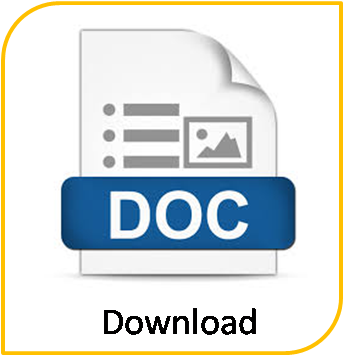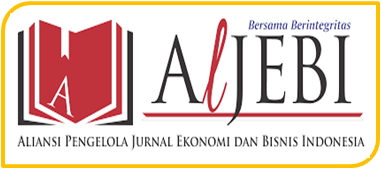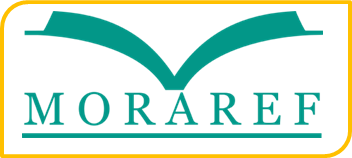SOSIO-EKONOMI SEBAGAI FAKTOR NON-PERFORMING FINANCING PADA LEMBAGA KEUANGAN MIKRO SYARIAH
Abstract
The study analyzes the factors that affect Non-Performing Financing (NPF) using the customer's socio-economic indicators (age, gender, education level, county). The research chose Indonesia as the object of research, because it has the largest Muslim population in the world and the development of Sharia Microfinance Institutions (MFIs) in this country is quite promising. To identify the factors that influence non-performing financing in Islamic MFIs, we use the logit model to estimate the probability of factors affecting NPF. The results of this study indicate that the socio-economic factors of the customer, namely age, gender, education level, influence problematic financing. The results of this study give a framework for making strategic policy to maintain Sharia MFIs stability based on the dimensions of age, gender, level and education.
Keywords
Full Text:
PDFReferences
Abdelkader, I. Ben. (2013). Islamic vs Conventional Microfinance Institutions : Performance analysis in MENA countries Islamic vs Conventional Microfinance Institutions : Performance analysis in MENA countries. International Journal of Business and Social Research (IJBSR), 3(5), 219–233. https://doi.org/10.18533/ijbsr.v3i5.21
Adnan, M. A., & Ajija, S. R. (2015). The effectiveness of Baitul Maal wat Tamwil in reducing poverty The case of Indonesian Islamic Microfinance Institution. Humanomics, 31(2), 160–182.
Afandi, M. A., & A, I. Q. (2018). The Forecasting Of Financial Inclusion In East Java Through Islamic Microfinance Institution : An Autoregres- Sive Integrated Moving Average Approach. JDE (Journal of Developing Economies), 3(2), 91–105. https://doi.org/10.20473/jde.v3i2.10513
Agarwal, S., Amromin, G., Ben-David, I., Chomsisengphet, S., & Evanoff, D. D. (2010). Learning to cope: Voluntary financial education and loan performance during a housing crisis. American Economic Review, 100(2), 495–500. https://doi.org/10.1257/aer.100.2.495
Aghion, B. A. De, & Morduch, J. (2004). Microfinance : Where do we stand. 135–148.
Ahmad, A. U. F., & Rafique Ahmad, A. B. (2009). Islamic microfinance: The evidence from Australia. Humanomics, 25(3), 217–235. https://doi.org/10.1108/08288660910986946
Akhter, W. (2009). Islamic Micro-Finance And Poverty Alleviation: A Case Of Pakistan. 1–8.
Amalia, E., & Rahmatullah, I. (2018). Strategic Alliances between Sharia Microfinance Institutions and Financial Technology in Strengthening Small Micro Enterprises for Socio Economic Justice. Proceedings Ofthe 1st International Conference on Recent Innovations (ICRI 2018), Icri 2018, 2444–2452. https://doi.org/10.5220/0009944224442452
Anuradha, P. A. N. S. (2020). Factors Affecting Non-Performing Loan Portfolio in Micro-Lending : Evidence from Sri Lanka. International Journal of Science and Research, 9(2), 1503–1507.
https://doi.org/10.21275/SR20212122256
Beckmann, E. (2013). Financial Literacy and Household Savings in Romania. Numeracy, 6(2). https://doi.org/10.5038/1936-4660.6.2.9
Ben-Akiva, M., & Lerman, S. R. (1997). Discrete Choice Analysis: Theory and Application to Travel Demand (Issue 5). The MIT Press.
Berhane, G., & Gardebroek, C. (2011). Does microfinance reduce rural poverty? Evidence based on household panel data from northern Ethiopia. American Journal of Agricultural Economics, 93(1), 43–55. https://doi.org/10.1093/ajae/aaq126
Berhane, G., & Gardebroek, C. (2012). Assessing the Long-term Impact of Microcredit on Rural Poverty: Does the Timing and Length of Participation Matter? In International Food Policy Research Institute, Sept 2012, 17.
Chong, B. S., & Liu, M. H. (2009). Islamic banking: Interest-free or interest-based? Pacific Basin Finance Journal, 17(1), 125–144. https://doi.org/10.1016/j.pacfin.2007.12.003
Dhumale, R., & Sapcanin, A. (1998). An Application of Islamic Banking Principles to Microfinance. Study by the Regional Bureau for Arab States, United Nations Development Programme, in Cooperation with the Middle East and North Africa Region, 1–14.
Dong, X., Ben-Akiva, M. E., Bowman, J. L., & Walker, J. L. (2006). Moving from trip-based to activity-based measures of accessibility. Transportation Research Part A: Policy and Practice, 40(2), 163–180.
https://doi.org/10.1016/j.tra.2005.05.002
Fianto, B. A., Gan, C., & Hu, B. (2019). Financing from Islamic microfinance institutions: evidence from Indonesia. Agricultural Finance Review, 79(5), 633–645. https://doi.org/10.1108/AFR-10-2018-0091
Fianto, B. A., Gan, C., Hu, B., & Roudaki, J. (2018). Equity financing and debt-based financing: Evidence from Islamic microfinance institutions in Indonesia. Pacific Basin Finance Journal, 52, 163–172.
https://doi.org/10.1016/j.pacfin.2017.09.010
Gaisina, S., & Kaidarova, L. (2017). Financial Literacy of Rural Population as a Determinant of Saving Behavior in Kazakhstan. Rural Sustainability Research, 38(333), 32–42. https://doi.org/10.1515/plua-2017-0010
Haque, M. G., Nurjaya, Affandi, A., Erlangga, H., & Sunarsi, D. (2021). Micro Financial Sharia Non-bank Strategic Analysis : a Study at. Budapest International Research and Critics Institute-Journal (BIRCI-Journal), 4(2), 1677–1686.
Hasbi, H. (2015). Islamic Microfinance Institution: The Capital Structure, Growth, Performance and Value of Firm in Indonesia. 211, 1073–1080. https://doi.org/10.1016/j.sbspro.2015.11.143
Hussain, M. (2015). Measurement of Poverty in Oic Member Countries : 1–82. https://doi.org/10.13140/RG.2.2.14405.86242
Li, X. (2010). an Empirical Analysis of Microcredit On China Rural Houshold. Lincoln University.
Li, X., Gan, C., & Hu, B. (2011). Accessibility to microcredit by Chinese rural households. Journal of Asian Economics, 22(3), 235–246.
https://doi.org/10.1016/j.asieco.2011.01.004
Littlefield, B. Y. E., Morduch, J., & Hashemi, S. (2003). Is Microfinance an Effective Strategy to Reach the Millennium Development Goals ? Focus Note, 24(January), 1–11.
Morduch, J. (1999). The role of subsidies in microfinance: Evidence from the Grameen Bank. Journal of Development Economics, 60(1), 229–248. https://doi.org/10.1016/S0304-3878(99)00042-5
Nursantika, S., Aspiranti, T., & Amaliah, I. (2017). Faktor-Faktor Yang Mempengaruhi Kinerja Keuangan Lkms Di Indonesia. Prosiding SNaPP2017Sosial, Ekonomi, Dan Humaniora, 727–734.
Parikh, T. S. (2006). Rural microfinance service delivery: Gaps, inefficiencies and emerging solutions. 2006 International Conference on Information and Communication Technology and Development, ICTD2006, 223–232. https://doi.org/10.1109/ICTD.2006.301861
Rahim, A., & Rahman, A. (2010). Islamic microfinance: An ethical alternative to poverty alleviation. Humanomics, 26(4), 284–295. https://doi.org/10.1108/08288661011090884
Re, R. Y., Hulwati, & Rozalinda. (2019). Pengaruh Kedalaman Jangkauan Pembiayaan Terhadap Keberlanjutan Keuangan Lembaga Keuanga N Mikro. JEBI (Jurnal Ekonomi Dan Bisnis Islam), 4(1), 15–17.
Train, K. E. (2003). Discrete choice methods with simulation. In Discrete Choice Methods with Simulation (Vol. 9780521816, Issue October). https://doi.org/10.1017/CBO9780511753930
Tulung, J. E., & Ramdani, D. (2015). The Influence of Top Management Team Characteristics on BPD Performance. International Research Journal of Business Studies, 8(3), 155–166.
https://doi.org/10.21632/irjbs.8.3.155-166
Umoh, G. S. (2006). Empirical investigation of access to micro-credit in an emerging economy: Evidence from Nigeria. Journal of African Business, 7(1–2), 89–117. https://doi.org/10.1300/J156v07n01_05
Vance, C. M., & McNulty, Y. (2014). Why and how women and men acquire global career experience: A study of American expatriates in Europe. International Studies of Management and Organization, 44(2), 34–54. https://doi.org/10.2753/IMO0020-8825440202
Wilson, E. M. (1998). Gendered career paths. Personnel Review, 27(5), 396–411. https://doi.org/10.1108/00483489810230334
Zubair, M. K. (2016). Analisis Faktor-Faktor Sustainabilitas Lembaga Keuangan Mikro Syariah. IQTISHADIA, 9(2), 201–226
DOI: https://doi.org/10.18860/ed.v10i1.14197
Refbacks
- There are currently no refbacks.
Editorial Office:
Megawati Soekarnoputri Building
Faculty of Economics
E-mail: eldinar@uin-malang.ac.id
Universitas Islam Negeri Maulana Malik Ibrahim Malang
E-ISSN 2622-0083

El Dinar under a CC BY SA 4.0 International License.
Member of:
Indexed By:
















